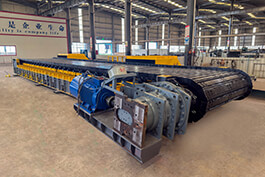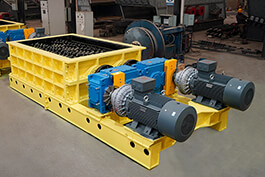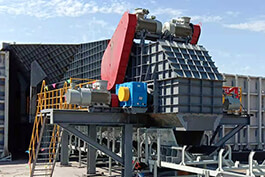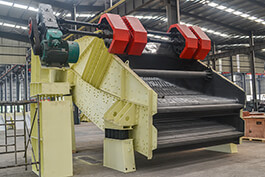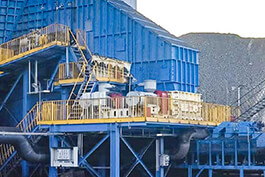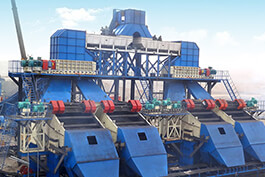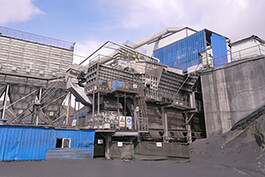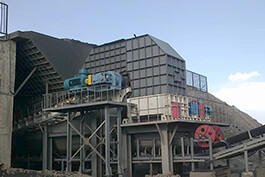Preface
In the production chain of the mining industry, the feeding process is of great significance. Its main function is to continuously and uniformly transport the raw ore with high hardness and large particle size to the subsequent crushing, screening and other processing equipment. The working environment is very harsh, usually accompanied by strong dust, high humidity, frequent impacts and vibrations. Now let's discuss with you why the Apron feeder is more suitable for mining applications than other feeders?
Type of feeders
Apron feeder
The Apron Feeder is suitable for transporting materials with large particle sizes over short distances. It is widely used in large-scale mining plants for feeding before crushing, serving as a primary crushing device for storing bins and achieving continuous and uniform feeding. It can also be used for heavy-duty short-distance material transportation, especially when the plate feeder is installed at the bottom of the bin, and the pressure of the materials directly acts on the feeding plate during heavy-load operation.
Working Principle
The power of the motor (or hydraulic motor) is transmitted through components such as couplings and reducers to drive the sprocket to rotate. The sprocket then drives the conveying chain and the chain plate to move forward together. The materials piled on the chain plate move forward along with the chain plate and are discharged at the head of the apron feeder to achieve continuous feeding. During operation, the working part of the conveying chain is supported by the upper idler wheels, while the return chain plate is supported by the lower idler wheels.
.jpg)
Vibrating Feeder
In the production process, the vibrating feeder can uniformly, regularly and continuously deliver block and granular materials from the storage bin to the receiving device. In the sand and stone production line, it can continuously and uniformly feed materials to the crushing machinery and conduct coarse screening of the materials. It is widely used in the crushing and screening combined equipment of industries such as metallurgy, coal mining, mineral processing, building materials, chemical industry, and abrasive materials.
Working Principle
The vibration force generated by the vibrating motor is transmitted to the vibrating screen plate, causing the materials to be transported under the action of the vibration force. The vibrating motor generates the vibration force through the exciter, and the vibration force causes the vibrating screen plate to vibrate, thereby pushing the materials forward.
Belt Feeder
The belt feeder operates by driving the conveyor belt to move through the drive rollers. It transports the materials placed on the conveyor belt from the loading point to the discharging point, enabling a relatively smooth material transportation.
Working Principle
It is driven by a transmission device to cause the conveyor belt to move in a circular motion, thereby transporting the materials. The materials enter the conveyor belt from the loading point, and the conveyor belt starts to move in a circular motion, transporting the materials forward along the conveying direction. The materials reach the discharging point after the circular movement of the conveyor belt, and are discharged from the discharging point, completing the transportation process.
Spiral feeder
The spiral feeder is suitable for transporting powdery, granular and small block materials. It is widely used in industries such as grain, chemical and building materials. It achieves the transportation by using the rotating spiral blades to push the materials along the fixed casing.
Working principle
The driving device (usually a motor combined with a reducer) drives the screw shaft to rotate, and the screw blades rotate accordingly. Under the combined effect of the material's own gravity, the friction force on the inner wall of the casing, and the thrust of the blades, the material continuously moves forward, achieving continuous transportation from the feed port to the discharge port.
Application of different feeders
Apron feeder
The Apron Feeder can complete heavy-duty tasks in harsh environments and has great adaptability to changes in material particle size, composition, temperature, viscosity, frost, rain, snow, or frozen materials. The Apron feeder is generally installed horizontally, but it can also be installed at an angle. The maximum upward transportation angle is 25 degrees.
Vibrating Feeder
The vibrating feeder can uniformly and continuously feed block and granular materials from the silo to the receiving device. In the sand and gravel production line, it can continuously and uniformly feed materials to the crusher to avoid blockage at the crusher's receiving port. It is specially designed for the uniform transportation of large blocks of materials in the coarse crusher of the crushing and screening process.
Belt feeder
Belt feeders are typically used to transport bulk and bagged materials, such as stones, sand, coal, concrete, cement, etc. When transporting materials, belt feeders are relatively stable. However, their adaptability to harsh environments is relatively weak. In environments with strong dust and high humidity, the conveyor belt is prone to wear and slipping, which affects the continuity and stability of material feeding. Design for uniform transportation of large pieces of materials.
Spiral feeder
Suitable for closed transportation of powdery and small particle materials as well as precise quantitative feeding operations. It is commonly used in powder batching systems, bottom discharge of silos, and other scenarios. The spiral feeder is sensitive to the moisture content and viscosity of the materials. Materials with excessive moisture or too high viscosity are prone to adhere to the spiral blades and the inner walls of the casing, resulting in reduced transportation efficiency or even blockage.
The reasons why apron feeders are more suitable for mining applications
Load-bearing capacity
The chain plate device of Apron feeder is composed of chain rails, trough plates, and bolts, etc. Its main function is to transport materials. The chain plates adopt a unit arc form and are welded from low-alloy steel plates, which have high strength, good wear resistance, and no material leakage.
High wear resistance
All the chain plates of the Apron feeder are made of 16Mn steel plates, which have extremely high hardness and wear resistance. Even when in contact and friction with highly hard and large-grained primary ores for a long time, they can effectively resist wear and significantly extend the service life of the chain plates.
Adapt to various material properties
The Apron feeder can easily handle various material properties encountered during mining processes: materials with a large amount of moisture, highly viscous ores, irregularly shaped and angular block materials, all can maintain stable feeding performance. The gap design between the chain plates is reasonable, which can prevent fine materials from leaking and ensure the smooth passage of large blocks, avoiding equipment failures caused by material blockages.
Conclusion
In the harsh environment of the mining industry, which is characterized by high requirements, high wear and tear, and a lot of dust, the Apron feeder outperforms vibrating feeders, belt feeders, and screw feeders, etc. due to its high load-bearing capacity, superior wear resistance, and wide adaptability to various materials. It can complete the feeding task more stably and efficiently.


.jpg)
